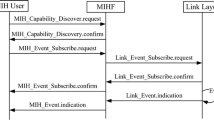Abstract
This paper describes methods for mode selection in multirate speech codecs, such as the AMR (Adaptive Multi-Rate), that is the mandatory speech codec selected in 3GPP (3rd Generation Partnership Project) defined mobile networks. Originally, the multirate functionality has been developed for coping with changing radio conditions. The algorithms described in this paper find applicability in IP-based mobile networks, where speech encoded data is encapsulated using the RTP (Real Time Protocol). The main advantages offered by these techniques are improved speech quality and congestion control along the network path between two mobile terminals.
Similar content being viewed by others
References
Anjum FM, Tassiulas L (1999, March 21–25) Fair bandwidth sharing among adaptive and nonadaptive flows in the internet. Proceedings of the 18th Annual Joint Conference of the IEEE Computer and Communications Societies (INFOCOM ’99), Vol. 3, pp 1412–1420
Athuraliya S, Low SH, Li VH, Yin Q (2001, May–June) REM: active queue management. IEEE Netw 15(3):48–53
Atungsiri SA, Tateesh S, Kondoz A (1997, June) Multirate coding for mobile communications link adaptation. IEE Proc Commun 133(3):211–216
Barberis A, Casetti C, De Martin JC, Meo M (2001, May 1) A simulation study of adaptive voice communications on IP networks. Comput Commun 24(9):757–767
Benmohamed LM, Dravida S, Harshavardhana P, Cheong Lau W, Mittal AK (1998, October–December) Designing IP networks with performance guarantees. Bell Labs Tech J 3(4):273–295
Bolot JC, Fosse-Parisis S, Towsley D (1999, March 21–25) Adaptive FEC-based error control for internet telephony, Proceedings of 18th annual joint conference of the IEEE Computer and Communications Societies (INFOCOM’99), Vol 3. New York, USA pp 1453–1460
Bruhn S, Blöcher P, Hellwig K, Sjöberg J (1999, May 16–20) Concepts and solutions for link adaptation and inband signaling for the GSM AMR speech coding standard. Proceedings of the 49th IEEE vehicular technology conference (VTC ’99), Vol. 3, pp 2451–2455
Casares Giner V (2001, May–June) Variable bit rate voice using hysteresis thresholds. Telecomm Syst 17(1–2):31–62
Christianson L, Brown K (1999, November 15–17) Rate adaptation for improved audio quality in wireless networks. Proceedings of the 6th international workshop on Mobile Multimedia Communications (MoMuC ’99), San Diego, California, USA pp 363–367
Cisco IOS quality of service solutions configuration guide, Release 12.2, (2001, August). http://www.cisco.com/univercd/cc/td/doc/product/software/ios122/122cgcr/fqos_c/qcfintro.htm
De Cnodder S, Elloumi O, Pauwel K (2000, July 3–6) RED behaviour with different packet sizes. Proceedings of the 5th IEEE Symposium on Computers and Communications (ISCC 2000), pp 793–799
ETSI TR 101 505, Adaptive Multi-Rate (AMR) speech codec, Study Phase Report, GSM 06.76 v. 7.0.2 2002–01
Floyd S. RED: discussion of byte and packet modes, March 1997 with comments from January 1998 and October 2000, http://www.aciri.org/floyd/REDaveraging.txt
Floyd S, Fall K (1997, February 15) Router mechanisms to support end-to-end congestion control. Unpublished manuscript, http://www.icir.org/floyd/papers/collapse.ps.
Floyd S, Jacobson V (1993, August) Random early detection gateways for congestion avoidance. IEEE/ACM Trans Netw 1(4):397–413
Floyd S, Gummadi R, Shenker S (2001, August 1) Adaptive RED: an algorithm for increasing the robustness of RED’s active queue management. Paper under submission, http://www.icir.org/floyd/papers/adaptiveRed.pdf
Galiotos P, Dagiuklas T, Arkadianos D (2002, July 3–5) QoS management for an enhanced VoIP platform using R-factor and network load estimation functionality. 5th IEEE International Conference on High Speed Networks and Multimedia Communications. pp 305–314
IETF RFC 3550, (2003, July) RTP: a transport protocol for real-time applications
IETF RFC 2309, (1998, April) Recommendations on queue management and congestion avoidance in the internet
IETF RFC 3267, (2002, June) RTP payload format and file storage format for the AMR and AMR-WB Audio Codecs
Jain R (1990, May) Congestion control in computer networks: issues and trends. IEEE Netw 4(3):24–30
Lakaniemi A, Ojala P, Toukomaa H (2002, October 6–9) AMR and AMR-WB RTP payload usage in packet switched conversational multimedia services. IEEE Workshop Proceedings on Speech Coding, pp 147–149
Mahajan R, Floyd S (2001, April) Controlling high bandwidth flows at the congested router. ICSI technical report, TR-01-001, http://www.aciri.org/floyd/papers/red-pd.TR.pdf
Matta J, Pepin C, Lashkari K, Jain R (2003, June 1–3) A source and channel rate adaptation algorithm for AMR in VoIP using the Emodel. Proceedings of the Network and Operating Systems Support for Digital Audio and Video Conference, Monterey, California, USA, pp 92–99
Nananukul S, Koodli R, Dixit S (2000, June 26–29) Controlling short-term packet loss ratios using an adaptive pushout scheme. IEEE Conference on High Performance Switching and Routing, Heidelberg (Germany), pp 49–54
Nomura T, Iwadare M (1999, June 20–23) Voice over IP systems with speech bitrate adaptation based on MPEG-4 wideband CELP. IEEE Workshop on Speech Coding, Porvoo, Finland, pp 132–134
Parekh AK, Gallager RG (1993, June) A generalized processor sharing approach to flow control in integrated services networks: the single-node case. IEEE/ACM Trans Netw 1(3):344–357
Seo JW, Woo SJ, Bae KS (2001, May 7–11) Study on the application of an AMR speech codec to VoIP. Proceedings of IEEE International Conference on Acoustics, Speech, and Signal Processing (ICASSP ’01), Salt Lake City, Utah, USA, Vol. 3, pp 1373–1376
3GPP TSG-SSA, AMR speech codec. General description (Release 4), TS 26.071 v. 4.0.0, 2001–03
3GPP TSG-SSA, AMR wideband speech codec. General description (Release 5), TS 26.171 v. 5.0.0, 2001–03
3GPP TSG-SSA, AMR wideband speech codec. Frame structure (Release 5), TS 26.201 v. 5.0.0, 2001–03
3GPP TSG-SSA, Performance characterization of the AMR speech codec (Release 4), TS 26.975 v. 4.1.0, 2001–09
3GPP TSG-SSA, AMR speech codec frame structure (Release 4), TS 26.101 v. 4.2.0, 2002–03
3GPP TSG-GERAN, Link Adaptation (Release 5), TS 45.009 v. 5.5.0, 2002–06
3GPP TSG-RAN, Packet Data Convergence Protocol (PDCP) Specification (Release 4), TS 25.323, v. 4.6.0, 2002–09
Author information
Authors and Affiliations
Corresponding author
Rights and permissions
About this article
Cite this article
Curcio, I.D.D., Kalliokulju, J. & Lundan, M. AMR mode selection enhancement in 3G networks. Multimed Tools Appl 28, 259–281 (2006). https://doi.org/10.1007/s11042-006-7714-9
Published:
Issue Date:
DOI: https://doi.org/10.1007/s11042-006-7714-9




